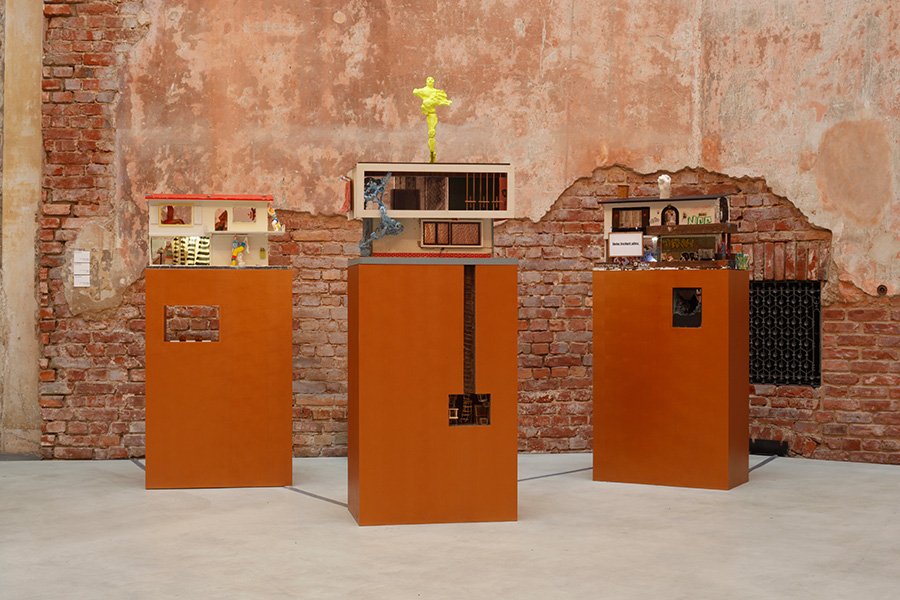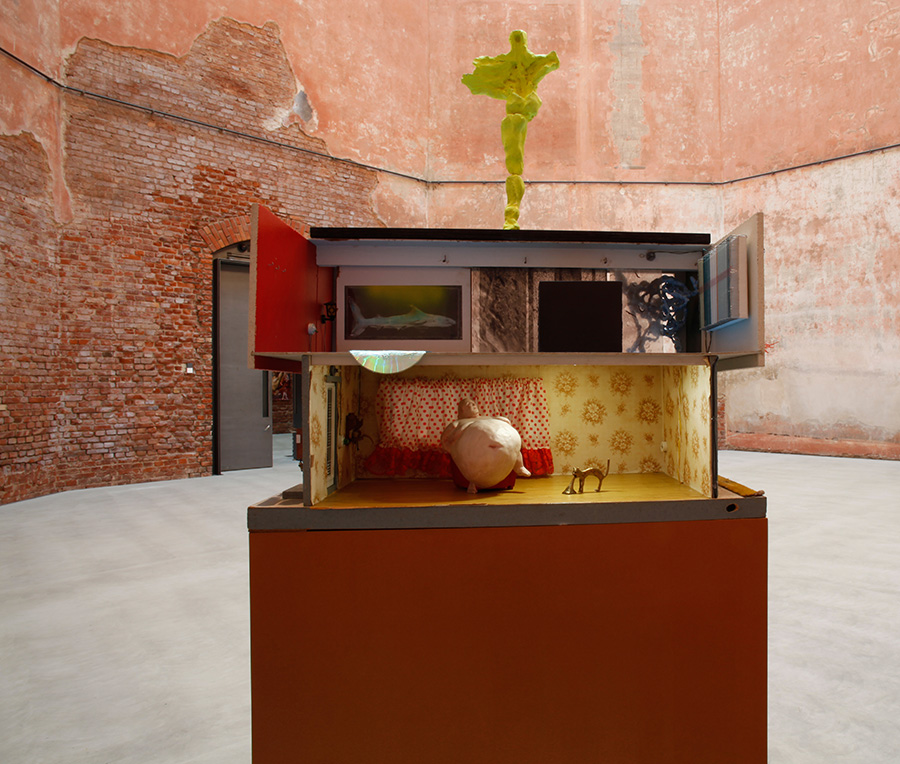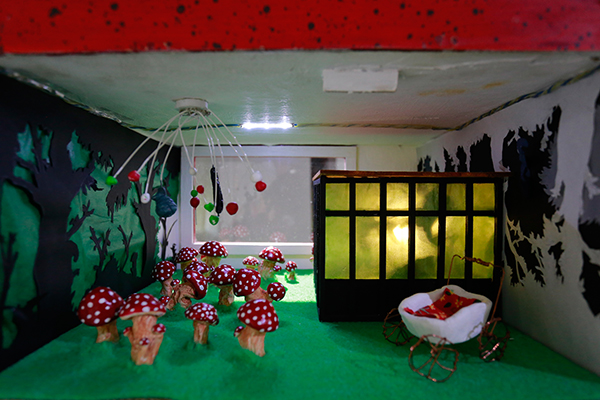Einleitung zur Minimal Art Gallery
Das Puppenhaus ist ein Ort der Möglichkeiten, wo ein Kind die Welt nach seinen Wünschen einrichten oder sie nach seinen Vorstellungen neu erschaffen kann. Suntje Sagerer knüpft mit dem Puppenhaus in der Minimal Art Gallery an diese Assoziationen an, indem die Künstler sich spielerisch austoben können.
Das Konzept der Minimal Art Gallery erwuchs dabei aus der bisherigen Beschäftigung Sagerers mit Puppenhäusern. Als Meisterstudentin der Hochschule für Bildende Künste (HfBK) Dresden hat sie bereits zwei Fotoserien angefertigt, deren Thema ein Puppenhaus war. In „Masters of Society“ und „to many children“ lässt die Künstlerin herkömmliche Puppen in einer Auswahl prekärer Szenarios innerhalb von Wohnräumen posieren und fotografiert das Ergebnis in leuchtenden, starken Farben. Die Bilder, von denen einige wiederum Fotos aus der Kindheit der Künstlerin enthalten, die in den Puppenstubenräumen eingebettet wurden, sind gleichermaßen lebhaft und befremdend. Mit ihren schäbigen, halberzählten Geschichten untergraben sie die konventionellen Vorstellungen einer unschuldigen Kindheit einerseits und des Zuhauses als tröstlichem Ort andererseits.
Während diese frühen Fotoserien die Erwartungen an die heimischen Gefilde untergraben, offeriert die Installation bzw. Skulptur der Minimal Art Gallery hingegen eine verspielte Alternative zu zeitgenössischen Kunsträumen. Die erste Version der Minimal Art Gallery wurde in der Galerie Mikky Burg, dem Gruppenatelier der Künstlerin im Dresdner Hechtviertel, gezeigt. Für dieses Projekt lud Sagerer andere Künstler ein, die das Konzept eines Puppenhauses neu erfinden sollten. Sie bat ihre Mitstreiter, Miniatur-Kunstwerke in dem Puppenhaus unterzubringen oder die Räume völlig neu zu gestalten. Der zweite Durchlauf dieser Idee, Minimal Art Gallery (Reloaded), wurde mit einer Gruppe teils neuer Künstler umgesetzt und in der Dresdner Galerie Baer ausgestellt.

Der Geist des Punk kennzeichnet beide Versionen der Minimal Art Gallery. Mit ihrer DIY (Do-it-yourself)-Energie umgehen sie die Autorität der Kunstwelt. Die Künstlerin schmeißt somit lieber ihre eigene Party, als eine Einbindung in den Mainstream anzustreben. Das Erscheinungsbild der Räume variiert dabei stark, immer abhängig vom Entwurf des jeweiligen Künstlers, doch die Kernstruktur – das Haus selbst – bleibt ein aufgeschnittener Bungalow aus den 1970er Jahren, der sein Innerstes bloßlegt. Die handgemachte Derbheit der Konstruktion ironisiert den sauberen weißen Ausstellungsraum. Der Titel Minimal Art Gallery unterstreicht ebenfalls eine verspielte Gegenbewegung zum Minimalismus, der ja als Namenspatron fungiert. Das einzig wirklich Minimale der Installation ist ihre Größe. Der deutlich heterodoxe Ansatz, der so viele rivalisierende Ästhetiken in einem Raum vereint, könnte hingegen nicht weiter entfernt sein von den standardisierten und einförmigen Werken von Minimalisten des 20. Jahrhunderts wie Donald Judd und Tony Smith.
Die Künstler, die an den beiden Ausgaben der Minimal Art Gallery teilnahmen, stellten sich der Herausforderung der verkleinerten Dimensionen des Hauses, indem sie entweder die Räume für ihre winzigen Kunstwerke neu entwarfen oder die Vorstellung von Raum gleich ganz platzen ließen. Die Flexibilität des Konzepts der Minimal Art Gallery erlaubt beliebig viele Annäherungen an die Aufgabe und lässt es zu, dass diese Arbeit immer und immer wieder in neuer Form entstehen kann.
Die einzige Regel: Das Kunstwerk muss passen. In den Einzelteilen liegt auch die Magie für den Betrachter. Wir beugen uns vor und spähen hinein, erhaschen einen kurzen Blick auf ein superkleines Gemälde an der Wand (Michael Klippmann) oder auf eine riesig aussehende Skulptur, die auf die Dimensionen des Hauses verkleinert wurde (Silke Wobst). Es gibt Witze des Maßstabs: gegenüber von Klippmanns Bild hängt ein rosa Hasenkopf, der in diesem Zusammenhang so groß wie der eines Bären wirkt; ins Badezimmer ist ein gefaltetes Papierschiffchen herkömmlicher Größe geklemmt, das die Puppenbadewanne – für die es gefertigt wurde – klein erscheinen lässt (Stefanie Busch); auf einem Tisch findet sich schließlich ein kleines weißes Haus, eine noch winzigere Version dessen, worin es sich gerade befindet (Robert Pappermann). In jedem Raum wird dem Betrachter Entzückung geboten, sichtbarer Witz und die Chance einzutauchen in die Puppenhaus-Gefilde der Phantasie und des Möglichen.
Jessica Buskirk, Ph.D. in Art History, University of California Berkeley
Deutsche Übersetzung: Torsten Klaus, Journalist, Kulturredakteur bei der DNN (Dresdner Neueste Nachrichten)
Origin of Minimal Art Gallery
The dollhouse is a place of possibility, where a child can order the world according to her desires or recreate it according to her imagination.In Minimal Art Gallery, Suntje Sagerer draws on these associations with the child’s dollhouse to transform the traditional exhibition space – the gallery – into an artist’s playground.

The concept of the Minimal Art Gallery grew out of Sagerer’s previous work with dollhouses. As a Masters’ student at the Dresden University of Fine Arts, she has produced two photo series that take the dollhouse as their subject. In Masters of Society and to many children, the artist poses old-fashioned dolls in a variety of precarious scenarios within the rooms of a home, photographing the tableaux in bright, stark color.
The images, some of which include photographs of the artist’s own childhood embedded in the space of the rooms, are at once vivid and alienating. With their sordid, half-told narratives, they undermine both conventional ideas about the innocence of childhood and the home as a place of comfort.

Whereas these earlier photo series subvert expectations of the domestic realm, the installation/sculpture, Minimal Art Gallery, offers a playful alternative to the contemporary art space.
The first version of the Minimal Art Gallery was exhibited in the Galerie Mikky Burg, collective in Dresden’s Hechtviertel. For this project, Sagerer invited fellow artists to reimagine the dollhouse – asking a group of collaborators to install miniature artworks in its rooms or to redesign the rooms entirely. A second iteration of the idea, Minimal Art Gallery (Reloaded), was created in association with a different group of artists and exhibited in the Galerie Baer.
Both versions of the Minimal Art Gallery are characterized by their punk spirit, bypassing the authority of the art world with a chaotic DIY (do-it-yourself) energy. Rather than striving for inclusion in the mainstream, the artist throws her own party. The appearance of the rooms varies wildly, depending on the artist who designed them, but the core structure – the house itself – remains a 70s-era bungalow, sliced open to reveal its contents. The handmade coarseness of the construction mocks the clean, white, stereotypical exhibition space.
The title of the project – Minimal Art Gallery – likewise underlines a playful opposition toward the Minimalism movement from which it takes its name. The only thing minimal about the installation is its size; its boldly heterodox approach, which brings so many competing aesthetics into one space, could not be farther from the standardized, uniform works of twentieth-century sculptors like Donald Judd and Tony Smith.

The artists who participated in the two iterations of the Minimal Art Gallery have taken the miniaturized dimensions of the houses as a challenge, redesigning rooms to house their tiny works or exploding the concept of the room itself.
The flexibility of the Minimal Art Gallery concept allows for any number of approaches to the task and permits the work to be remade in new forms, again and again.
The only rule is that the artwork must fit. This is the magic of the piece for the viewer; bending over, peering in, we glimpse a super-small painting on the wall (Michael Klippmann) or monumental-looking sculpture reduced to the dimensions of the house (Silke Wobst).
There are jokes of scale: hanging on the wall across from Klipmann’s painting is a pink rabbit’s head that in context seems as big as a bear’s; jammed into the space of the bathroom is a regular-sized folded paper ship, which dwarfs the doll bathtub for which it is made (Stefanie Busch); and finally sitting on a table is a small, white house, an even more miniature version of the structure that contains it (Robert Papperman). In every room, the viewer is offered enchantment, visual wit, and the chance to re-immerse oneself in the dollhouse’s realm of imagination and the possible.
Jessica Buskirk, Ph.D. in Art History, University of California, Berkeley
